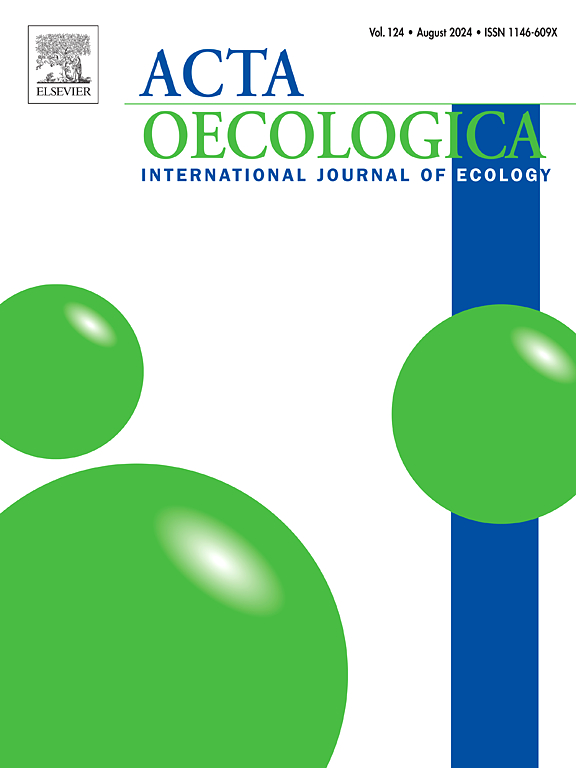资源竞争:什么因素导致蜜蜂胜过其他昆虫竞争者?
IF 1.3
4区 环境科学与生态学
Q3 ECOLOGY
Acta Oecologica-International Journal of Ecology
Pub Date : 2025-04-13
DOI:10.1016/j.actao.2025.104077
引用次数: 0
摘要
被管理的蜜蜂(Apis mellifera)的觅食活动对于为蜂群收集食物供应至关重要。养蜂人将蜂群暂时安置在选定的开花地区,以便为特定作物(如杏仁)授粉,或生产有价值的蜂产品,如蜂蜜和花粉,或两者兼而有之。然而,在这些选定的地区,蜜蜂觅食者和其他访花昆虫之间的竞争可能会出现。这种竞争会对蜜蜂作为传粉者的效率产生负面影响,并降低蜂群的生产力。各种因素可以帮助觅食蜂在花期暂时战胜竞争对手。了解这些因素对于优化觅食效率以确保高产量或有效地实现目标授粉至关重要。本文综述了蜜蜂与其他访花昆虫之间资源竞争的最新文献,以及蜜蜂对花卉资源的觅食行为。它旨在探索和讨论使蜜蜂觅食者暂时胜过其他竞争对手的关键因素。本文强调了景观结构、蜜蜂亚种和蜂群健康在花卉资源管理中的重要性。此外,它强调了群体数量及其分布的关键作用。考虑到蜜蜂的行为可塑性,以回应其他花卉访问者,已讨论,以及有利的觅食条件的检查。这篇文章提供了一个有价值的概述管理蜜蜂觅食生态,识别知识差距和建议未来的研究途径。本文章由计算机程序翻译,如有差异,请以英文原文为准。
Competition for resources: What factors lead honey bees to outcompete other insect competitors?
The foraging activity of managed honey bees, Apis mellifera, is crucial for collecting food supplies for colonies. Beekeepers place their colonies temporarily in selected flowering areas for the pollination of specific crops (e.g., almonds) or for the production of valuable bee products such as honey and pollen, or for both purposes. However, competition between honey bee foragers and other flower-visiting insects can arise in these chosen areas. This rivalry can have a negative impact on the efficiency of honey bees as pollinators and reduce productivity from colonies. Various factors can help forager bees temporarily overcome their competitors during the blossom period. Understanding these factors is crucial for optimizing foraging efficiency to ensure high productivity from colonies or achieve targeted pollination efficiently. This mini-review examines recent literature on resource competition between honey bees and other flower-visiting insects, as well as related topics on honey bee foraging behavior on floral resources. It aims to explore and discuss the key factors that enable honey bee foragers to temporarily outcompete other rivals. The article underscores the importance of landscape structure, honey bee subspecies, and colony health in managing floral resources. Moreover, it highlights the critical role of colony numbers and their distribution. Considerations regarding the behavioral plasticity of honey bees in response to other floral visitors have been discussed, alongside the examination of favorable foraging conditions. This article provides a valuable overview of the management of honey bee foraging ecology, identifying knowledge gaps and suggesting future research avenues.
求助全文
通过发布文献求助,成功后即可免费获取论文全文。
去求助
来源期刊
CiteScore
3.60
自引率
0.00%
发文量
57
审稿时长
>0 weeks
期刊介绍:
Acta Oecologica is venue for the publication of original research articles in ecology. We encourage studies in all areas of ecology, including ecosystem ecology, community ecology, population ecology, conservation ecology and evolutionary ecology. There is no bias with respect to taxon, biome or geographic area. Both theoretical and empirical papers are welcome, but combinations are particularly sought. Priority is given to papers based on explicitly stated hypotheses. Acta Oecologica also accepts review papers.

 求助内容:
求助内容: 应助结果提醒方式:
应助结果提醒方式:


